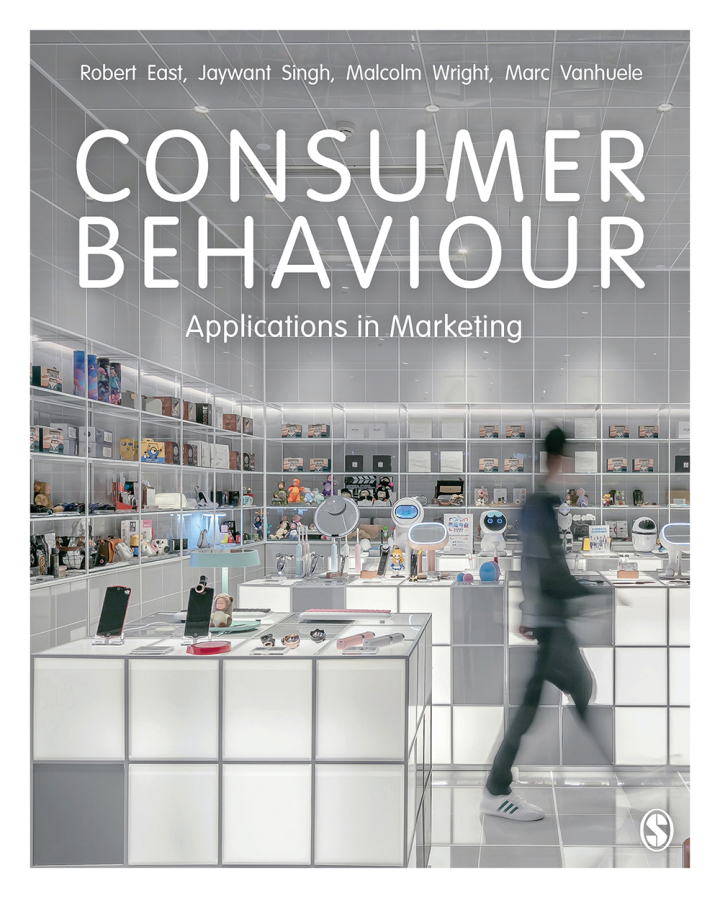
Consumer Behaviour 4th Edition - Applications in Marketing
PUBLISHER: Sage
Trường ĐH, Nhóm, Thư Viện: Gọi 0915920514 để báo giá eBook hosting trên Vital Source hoặc mua Sách In
Hành vi người tiêu dùngỨng dụng trong tiếp thị'Một văn bản nghiêm túc, chu đáo về hành vi của người tiêu dùng, tập trung vào nội dung hơn là những thứ thời thượng trong giới học thuật.' Giáo sư Byron Sharp, Viện Ehrenberg-Bass, Đại học Nam Úc 'Một văn bản kích thích tư duy thách thức người đọc xem xét hành vi của người tiêu dùng trong những cách thức mới mẻ và mới mẻ, đồng thời suy ngẫm về những hành vi thường ngày chiếm phần lớn cuộc sống hàng ngày – mua hàng hiệu, ghé thăm các cửa hàng, xem quảng cáo, đưa ra đề xuất.' Với các học giả tiếp thị, cuốn sách giáo khoa phổ biến này vượt ra ngoài cách tiếp cận tâm lý cơ bản đối với Hành vi của người tiêu dùng bằng cách cung cấp sự hiểu biết thực nghiệm hơn về chủ đề này, giúp sinh viên nắm bắt các ứng dụng tiếp thị ở cả cấp độ cá nhân và thị trường. Phiên bản thứ tư duy trì sự tập trung mạnh mẽ vào nghiên cứu, đặc biệt là các phương pháp định lượng, giúp sinh viên trình độ cao hơn phát triển tư duy phân tích và dựa trên bằng chứng để thành công trong nghiên cứu tiếp thị dựa trên học thuật và dựa trên ngành. Sách giáo khoa chứa các ví dụ, bài tập và kết quả nghiên cứu mới, cùng với những tiến bộ gần đây trong môi trường kỹ thuật số. Thích hợp cho sinh viên đại học và sau đại học tham gia các khóa học về hành vi của người tiêu dùng cũng như các ứng viên tiến sĩ tập trung vào hành vi của người tiêu dùng. Robert East là Giáo sư danh dự tại Đại học Kingston London, Vương quốc Anh. Jaywant Singh là Giáo sư Tiếp thị tại Trường Kinh doanh Southampton, Đại học Southampton, Vương quốc Anh. Malcolm Wright là Giáo sư Tiếp thị tại Đại học Massey, New Zealand. Marc Vanhuele là Giáo sư Tiếp thị tại HEC Paris, Pháp.
About the AuthorsPrefaceAcknowledgementsPraise for Previous EditionsPART 1 INTRODUCTION1 Ideas and Explanations in Consumer ResearchSection 1: The scope of consumer behaviourSection 2: Consumer decision modelsSection 3: Classifications and explanationsPART 2 CONSUMPTION PATTERNS2 Customer LoyaltySection 1: Brand loyalty in repertoire categoriesSection 2: The rise of relationship marketing – customer loyalty as retentionSection 3: Combination definitions of loyaltySection 4: Reasons for defection3 Brand Knowledge, Brand Equity and Brand ExtensionSection 1: The mental representation of brandsSection 2: Brand equity, brand extension and brand alliancesSection 3: Sales losses by the parent of a line extension4 Stationary MarketsSection 1: Modelling mature marketsSection 2: Single brand purchase patternsSection 3: Patterns of purchase in the whole category5 Market DynamicsSection 1: Changes in aggregate salesSection 2: Dynamic effects and brand loyaltySection 3: The dynamics of new product adoptionSection 4: The sales dynamics of frequently bought categories6 Consumer Group DifferencesSection 1: Relevant differences for consumer researchSection 2: National cultural differencesSection 3: Cultural differences in consumer researchSection 4: Age and gender differences in consumptionPART 3 EXPLAINING DECISION MAKING7 Predicting and Explaining BehaviourSection 1: Definitions and measurementsSection 2: The theory of planned behaviourSection 3: Problems with the theory of planned behaviour8 Information Processing and Decision MakingSection 1: Schemas and attentionSection 2: HeuristicsSection 3: Processing value and probabilitySection 4: Financial applications of heuristics and biases9 Consumer Satisfaction and QualitySection 1: IntroductionSection 2: Theories of consumer satisfactionSection 3: Measuring satisfaction and service qualitySection 4: Outcomes of satisfaction and dissatisfactionPART 4 MARKET RESPONSE10 Consumer Response to Price and Sales PromotionsSection 1: Consumer response to priceSection 2: Estimating price sensitivitySection 3: Psychological reactions to prices and price changesSection 4: Consumer response to sales promotions11 Shopper BehaviourSection 1: Shopper choiceSection 2: Customer typologiesSection 3: The store environment12 Word-of-mouth InfluenceSection 1: The nature of word of mouthSection 2: The occurrence of word of mouthSection 3: The impact of word of mouthSection 4: Word of mouth in the social networkSection 5: Applications of word-of-mouth research13 The Response to AdvertisingSection 1: Effective advertisingSection 2: Advertising frequency and concentrationSection 3: A model of advertising effectSection 4: Specific effectsSection 5: Developments in digital advertisingSection 6: Biometrics and consumer neuroscienceReferencesIndex















